Cool your sun-cooked food quickly from 135°F to 70°F within 2 hours, then to 41°F within 4 hours using shallow containers or ice baths. Store food in BPA-free or glass airtight containers, properly labeled with dates and contents. Maintain refrigerator temperatures at 41°F or below, and freezer temperatures at 0°F. Keep food in a clean, designated storage area away from contaminants, and use separate containers for different food types. Don't leave food at room temperature for more than 2-4 hours. Monitor for spoilage signs like unusual odors or discoloration. These essential storage practices are just the beginning of ensuring your sun-cooked meals stay fresh and safe.
Rapid Cooling Before Storage
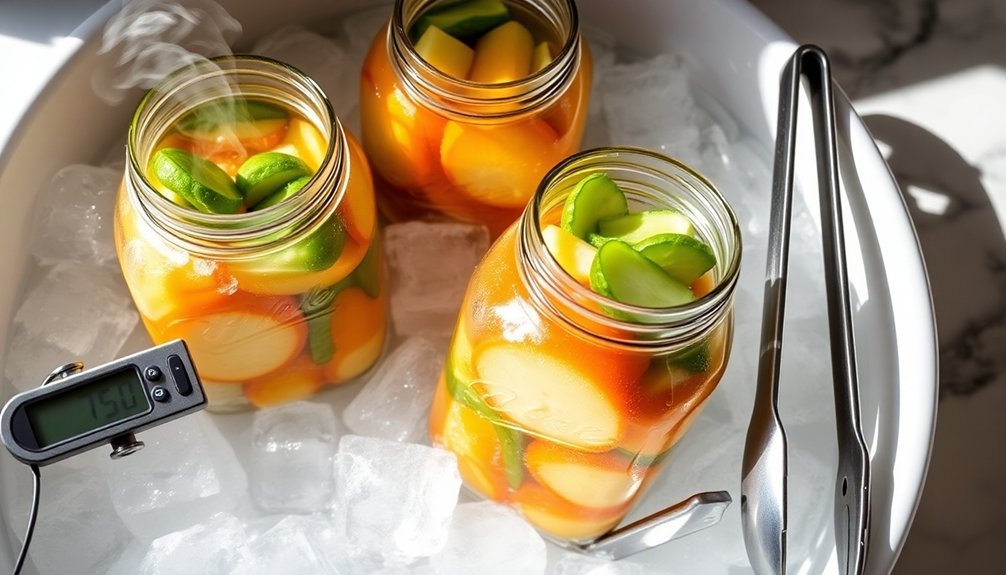
When storing sun-cooked food safely, proper cooling techniques are vital to prevent bacterial growth.
You'll need to cool your food from 135°F to 70°F within 2 hours, then down to 41°F within the next 4 hours to stay in the safe zone.
To cool your sun-cooked dishes quickly, transfer them to shallow pans or cut larger items into smaller pieces.
Use pre-chilled containers from your refrigerator, or place your food in an ice water bath. Stirring frequently helps release trapped heat and guarantees even cooling throughout.
Don't forget to leave containers uncovered to let warm air escape.
If you're dealing with thick liquids or stews, try using an ice paddle. Bacteria multiply rapidly in the temperature danger zone, so proper cooling is essential for food safety.
Airtight Container Selection
When choosing containers for your sun-cooked food, opt for BPA-free plastic over glass since plastic offers better durability and lower breakage risk during handling.
You'll want containers with reliable sealing technology, such as Tightvac's vacuum seal or OXO POP's silicone lids, to maintain freshness and prevent spoilage. Tightvac containers remain effective in preserving food quality even when they are only 10% full, making them versatile for varying portion sizes.
Pick container sizes that match your portion needs while considering stackability for efficient storage, as overfilled or partially empty containers can compromise food preservation.
Glass vs. Plastic Containers
Selecting the right airtight containers for your sun-cooked food can greatly impact its freshness and shelf life. While both glass and plastic containers have their merits, glass offers superior benefits for storing sun-cooked meals. Glass containers won't leach chemicals into your food, remain odor-free, and can withstand temperature changes without warping.
If you're planning to transport your sun-cooked food, plastic containers might be more practical due to their lightweight nature and unbreakable design. However, they're more prone to staining and absorbing odors. When choosing plastic, opt for BPA-free options with recycling codes 1, 2, 4, or 5. Society's reliance on plastic contributes to environmental concerns, with one million plastic bottles being purchased every minute globally.
Remember that glass containers are easier to clean, more durable, and allow you to quickly identify contents. They're also safer for reheating and won't deteriorate over time like plastic alternatives.
Sealing Technology Matters
Since preserving sun-cooked food relies heavily on proper storage methods, choosing containers with advanced sealing technology is essential for maintaining freshness.
You'll want to select containers with silicone gaskets or precision-engineered locking mechanisms that create a hermetic seal, preventing air from entering or escaping.
Look for containers with vacuum-sealing capabilities, as they remove air before sealing and greatly inhibit bacterial growth and oxidation.
They're particularly effective for sun-cooked foods, which can last up to five times longer when properly sealed.
Modern stainless steel containers offer exceptional durability while being completely recyclable and safe for all types of food storage.
Choose BPA-free containers featuring a double lip design and air-expel channels for maximum efficiency.
Remember to hand-wash your containers instead of using the dishwasher to maintain their sealing integrity.
When properly maintained, these containers can protect your sun-cooked meals effectively for years.
Container Size Selection
Three key factors determine the ideal container size for storing sun-cooked food: the quantity you prepare, the food's physical characteristics, and your available storage space.
For smaller portions of sun-cooked dishes, choose containers between 0.7oz to 16oz. You'll find these sizes perfect for individual servings and compact storage.
If you're preparing larger batches, opt for containers up to 5lbs capacity to accommodate family-sized portions.
Consider your food's shape and texture when selecting containers. Long containers work best for items like sun-dried pasta, while wider, shallower containers suit layered dishes.
If you're dealing with limited storage space, look for stackable containers with universal lids. They'll help maximize your cabinet or refrigerator space while keeping your sun-cooked meals fresh and organized.
Temperature Control During Storage
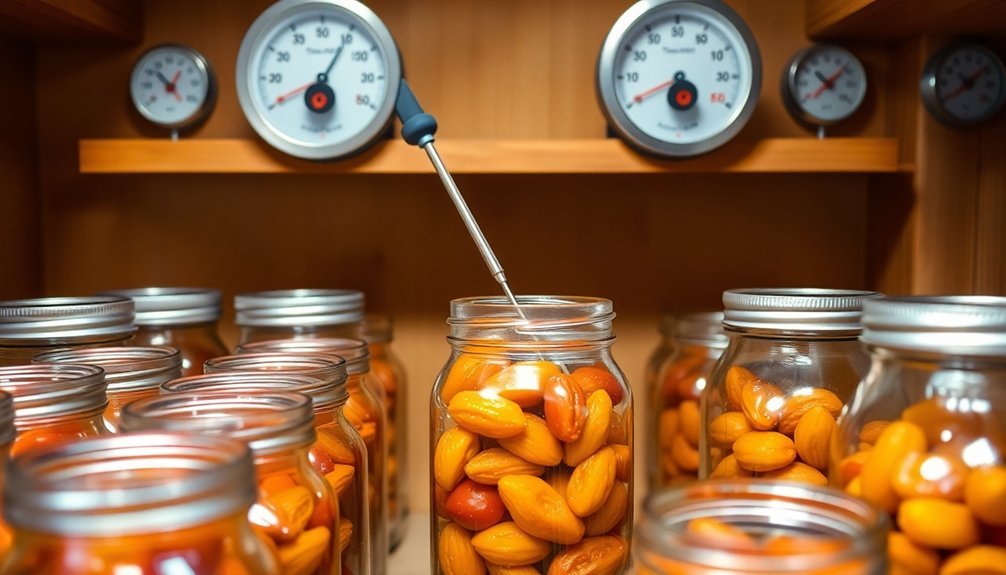
You'll need to maintain proper temperature control for your sun-cooked food by cooling it rapidly to below 50°F (10°C) before storage.
Your refrigerated items, including meats and dairy products, must stay at or below 41°F (5°C) to prevent bacterial growth and guarantee food safety.
For shelf-stable items, keep them in a cool, dark place between 50°F and 70°F (10°C and 21°C), away from heat sources and direct sunlight.
Safe Temperature Ranges
Maintaining proper temperature control is critical for safely storing sun-cooked food.
You'll need to keep your prepared meals below 40°F (4.4°C) or above 140°F (60°C) to prevent harmful bacterial growth. Your refrigerator should maintain a consistent temperature of 41°F (5°C) or lower for ideal food safety.
If you're freezing your sun-cooked meals, set your freezer to 0°F (-17.7°C) or below.
Don't let your food linger in the danger zone between 40°F and 140°F (4.4°C to 60°C), as this range promotes rapid bacterial growth.
You'll want to check food temperatures every two hours using a reliable thermometer. If you find any items that have stayed in the danger zone for more than 2-4 hours, it's best to discard them to guarantee your safety.
Monitoring Storage Heat Levels
When storing sun-cooked food, proper temperature monitoring becomes your first line of defense against foodborne illness.
You'll need a digital probe thermometer to check internal food temperatures regularly, ensuring they stay below 50°F (10°C) for extended storage.
Don't rely on guesswork – use temperature indicators to verify your storage conditions remain in safe ranges.
You'll want to cool cooked foods quickly if you're planning to store them for more than three to four hours.
Place your storage containers in areas with consistent temperatures, avoiding spots prone to fluctuation.
Keep an eye on environmental factors that could affect your storage temperatures.
Weather changes, altitude, and time of day can impact heat levels.
You'll get better results by using insulated containers with dark-colored, tight-fitting lids to maintain steady temperatures.
Preventing Cross-Contamination While Storing
The proper storage of sun-cooked food requires careful attention to prevent cross-contamination, which can lead to foodborne illness.
You'll need to use clean, well-sealed containers labeled with the food's name and expiration date. Cover your food with tight-fitting plastic wrap or aluminum foil.
Store your sun-cooked food in designated areas away from dishwashing stations, garbage rooms, and restrooms. Keep raw meats, poultry, and dairy separate from ready-to-eat foods.
When storing different foods in the refrigerator, follow the top-to-bottom order: whole fish, beef and pork cuts, ground meats, and poultry.
Don't forget to maintain proper hygiene by washing your hands thoroughly and using sanitized utensils instead of bare hands.
Regularly sanitize kitchen surfaces and equipment to maintain a safe storage environment for your sun-cooked meals.
Freezer Storage Methods
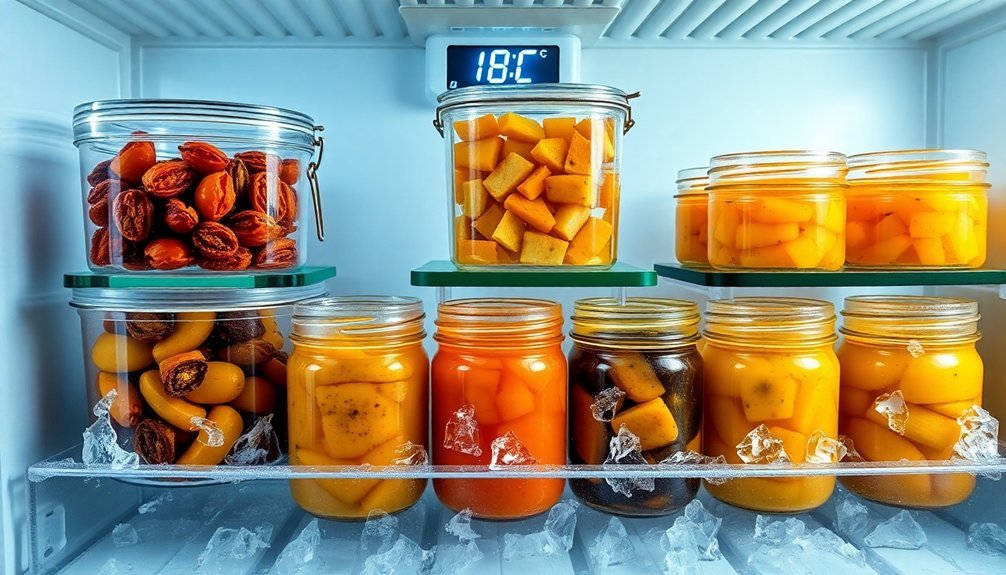
Proper freezer storage begins with cooling your sun-cooked food completely before freezing.
When you're ready to freeze, wrap your food tightly or place it in sealed containers to prevent freezer burn. Make sure the food is completely dry to stop bacteria and mold growth, and divide it into practical portions for easier thawing later.
You'll want to maintain your freezer at -18°C (0°F) for ideal long-term storage.
Label each container with the date and contents so you can track freshness and use older items first.
Don't overcrowd your freezer, as this affects air circulation and temperature consistency.
If you're using a star-rated freezer, remember that **** ratings offer the longest storage times of three months or more, while * ratings only guarantee freshness for up to one week at -6°C.
Safe Refrigeration Techniques
Moving from freezer to refrigerator storage requires equal attention to detail for your sun-cooked foods. Set your refrigerator temperature at 41°F or below and use a thermometer to monitor any fluctuations.
You'll need to arrange your sun-cooked items strategically, placing ready-to-eat portions on the top shelf to prevent cross-contamination from other foods.
Don't line your shelves with foil or sheet pans, as this blocks proper air circulation. Instead, store your items in clean, sealed containers that are clearly labeled with dates.
When storing larger batches, divide them into shallow containers for quick cooling. Make sure you're not overcrowding the fridge, as this can raise the internal temperature.
Wipe spills immediately and maintain regular cleaning schedules to keep your sun-cooked foods safe and fresh.
Room Temperature Storage Guidelines
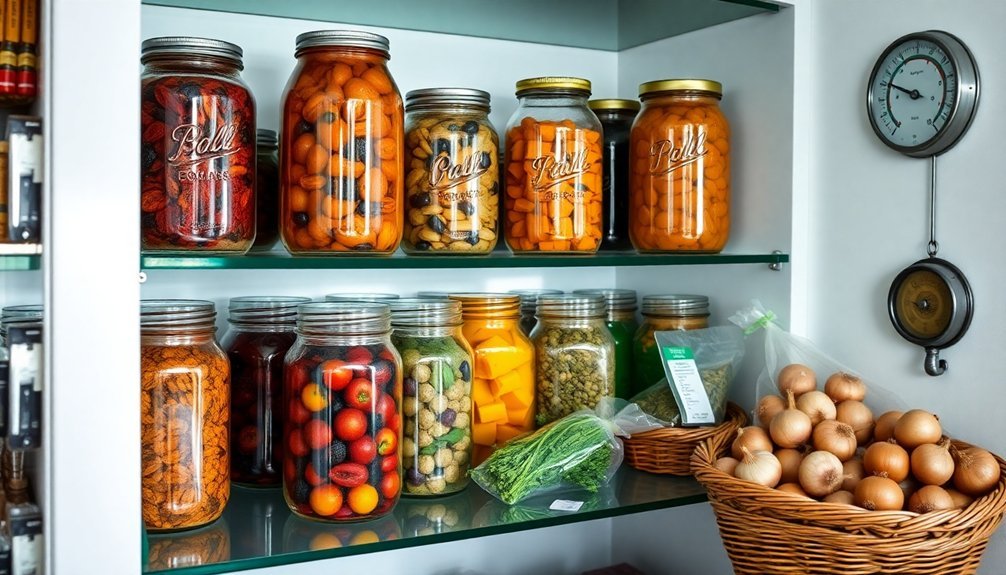
Since maintaining proper temperatures is essential for sun-cooked food safety, you'll need to understand the danger zone between 40°F and 140°F where bacteria thrive.
Don't leave your sun-cooked food at room temperature for more than 2-4 hours, as harmful bacteria can multiply rapidly during this time.
When storing food at room temperature, choose a cool, dry space away from direct sunlight where temperatures stay between 50°F and 70°F.
Keep humidity levels under 15% to prevent mold growth. You'll want to use food-grade plastic containers or Mylar bags that create an airtight seal.
A basement often provides ideal conditions for storage. Before consuming stored food, always check for warning signs of spoilage like unusual odors, bubbling, or discoloration.
Remember that reheating won't eliminate toxins that bacteria may have produced.
Frequently Asked Questions
Can Sun-Cooked Food Be Reheated Using a Solar Cooker?
Yes, you can reheat sun-cooked food using a solar cooker, but you'll need to guarantee it reaches 165°F for safety. Make sure you're reheating during peak sunlight hours between 11 AM and 3 PM.
How Long Can Sun-Cooked Meals Stay Fresh in a Power Outage?
You'll need to treat your sun-cooked meals like any other cooked food during a power outage. Don't keep them at room temperature over 2 hours, or 1 hour if it's above 90°F. Use coolers with ice.
Does Sun-Cooking Affect the Recommended Storage Time Compared to Conventional Cooking?
No, sun-cooking doesn't change recommended storage times. You should follow the same food safety rules: refrigerate within 2 hours, store hot food above 140°F, cold food below 40°F, and consume leftovers within 3-5 days.
Are Special Containers Required for Storing Food Cooked in Solar Ovens?
You don't need special containers for solar-cooked food. Just use standard sealed, insulated containers with tight-fitting lids. Guarantee they're clean and can maintain proper temperature to keep your food safe for storage.
Can Condensation in Storage Containers Affect Sun-Cooked Food Differently?
You'll find that condensation affects sun-cooked food the same way as traditionally cooked food. It can make your dishes soggy, but it won't impact safety as long as you've stored them at proper temperatures.
In Summary
You'll find that proper storage of sun-cooked food isn't complicated when you follow these essential guidelines. From rapid cooling to airtight containers and temperature control, each step helps preserve your food's safety and flavor. Whether you're using your freezer, refrigerator, or pantry space, remember that preventing cross-contamination and maintaining proper storage conditions will keep your sun-cooked meals fresh and ready to enjoy.

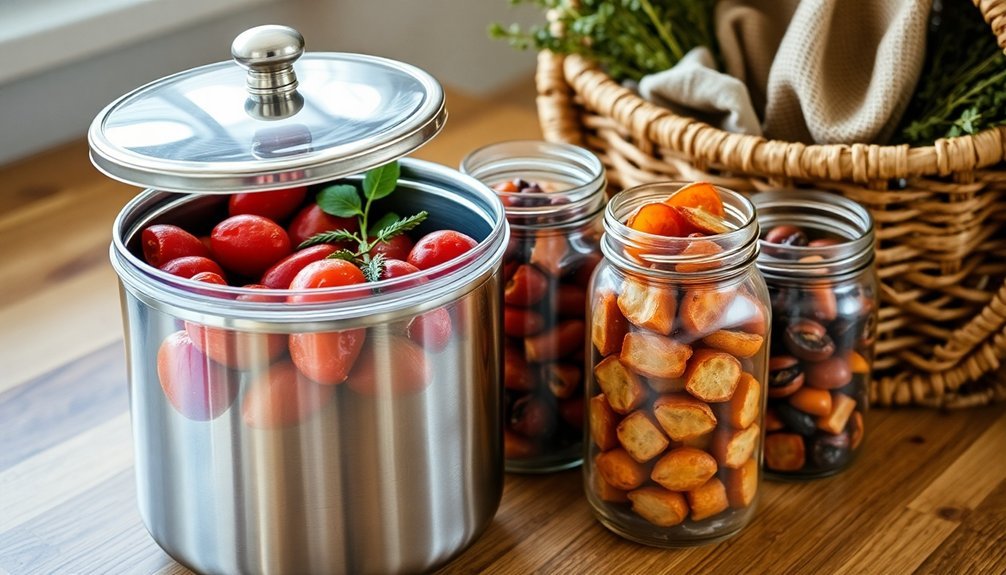



Leave a Reply